Hellraiser III: Hell on Earth
2.8 /10 2 Votes
17% Rotten Tomatoes Genre Horror Duration Country United StatesCanada | 5.4/10 IMDb Language English | |||||||||||||||||||||||||||||||||
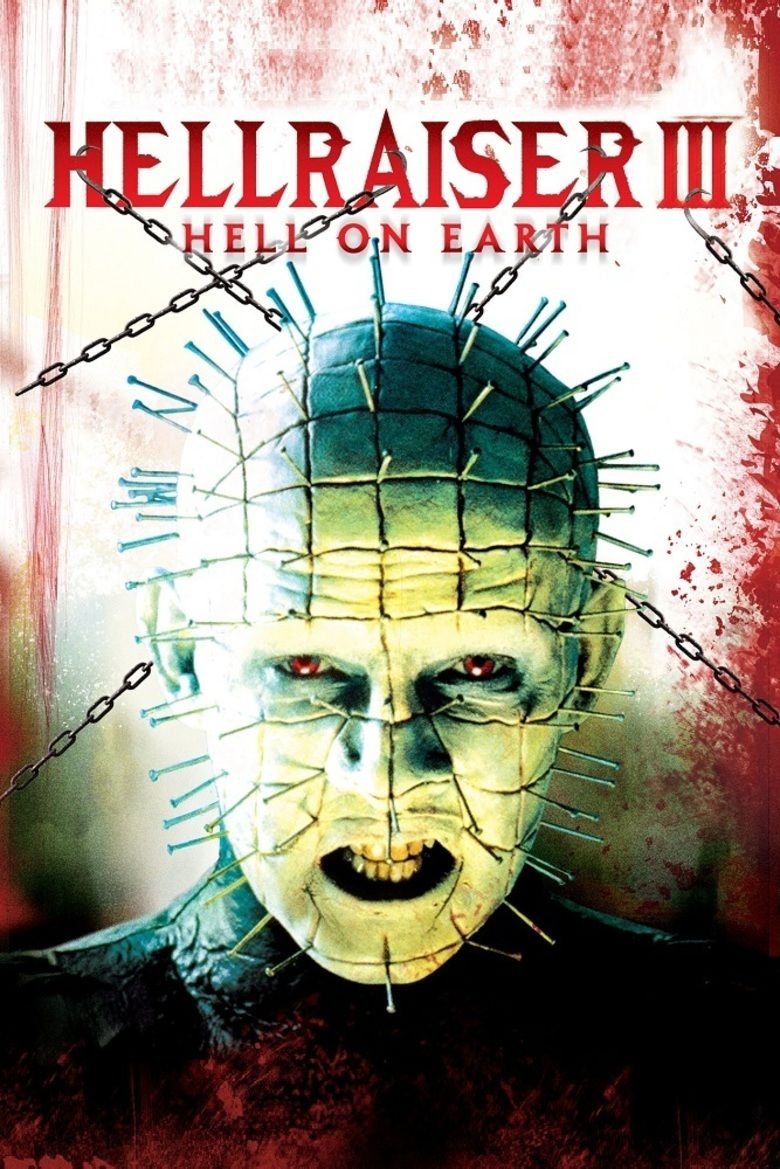 | ||||||||||||||||||||||||||||||||||
Release date September 11, 1992 (1992-09-11) Producers Lawrence Mortorff, Christopher Figg Cast (J.P. Monroe), (Joanne 'Joey' Summerskill), Ken Carpenter (Daniel 'Doc' Fisher), (Pinhead), (Terri), Philip Hyland (Brad)Similar movies Tagline What started in hell, will end on Earth | ||||||||||||||||||||||||||||||||||
hellraiser iii hell on earth 1992 theatrical trailer
Hellraiser III: Hell on Earth is a 1992 American horror film and third installment in the Hellraiser series, directed by Anthony Hickox and starring Doug Bradley, Terry Farrell, Paula Marshall, and Kevin Bernhardt. It was the first Hellraiser film to be filmed outside the United Kingdom. This was the first Miramax release under its Dimension Films banner and was distributed by Paramount Pictures.
Contents
- hellraiser iii hell on earth 1992 theatrical trailer
- Plot
- Cast
- Development
- Pre production
- Filming
- Post production
- Themes
- Soundtrack
- Release
- Reception
- References
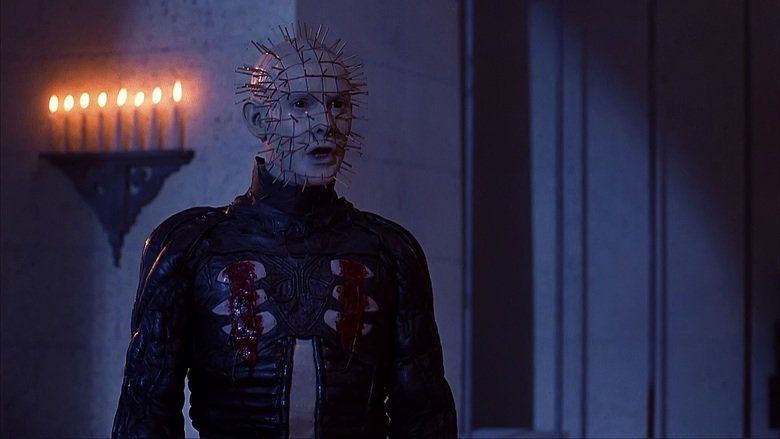
Plot
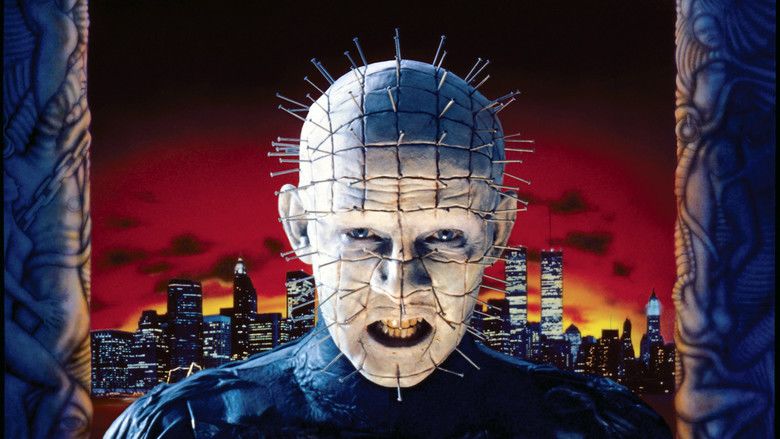
The revelation of his own former humanity in Hellraiser II has resulted in the Cenobite, Pinhead, being split into two different entities: his former self, World War I British Army Captain Elliot Spencer, and a manifestation of Spencer's id, which takes on the form of Pinhead. While Spencer ends up in limbo, Pinhead is trapped, along with the puzzle box, among the writhing figures and distorted faces etched into the surface of an intricately carved pillar — the Pillar of Souls.
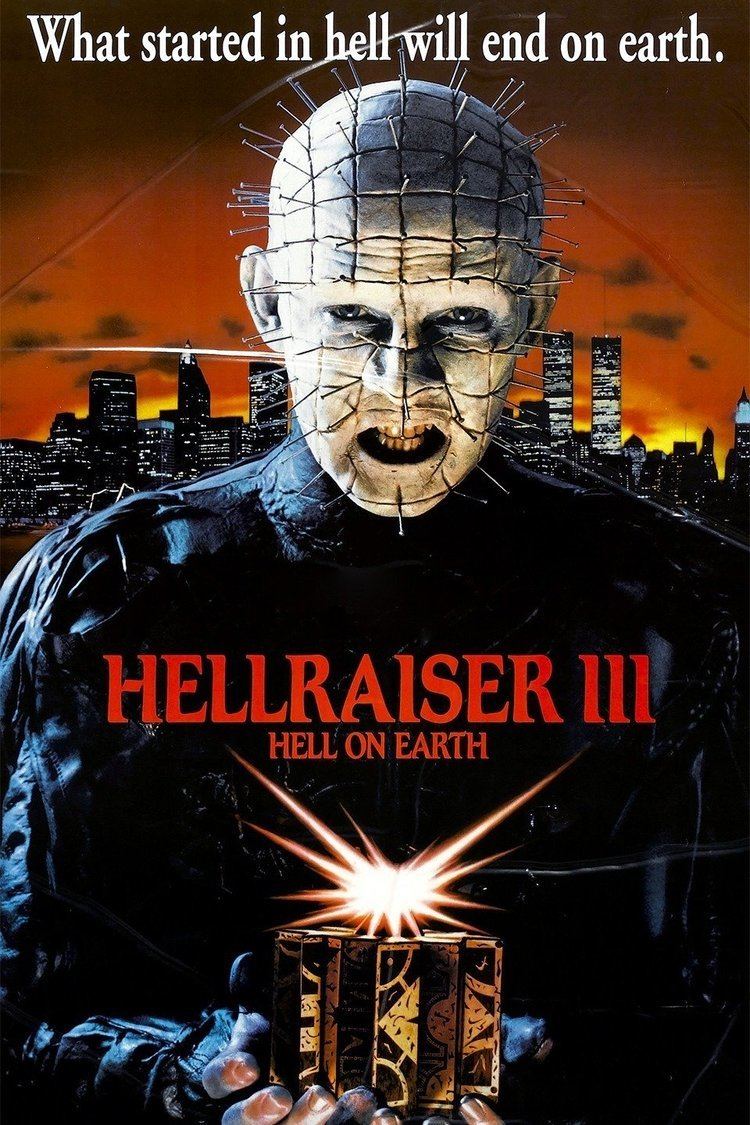
The pillar is bought by J. P. Monroe, the rich owner of a popular nightclub called The Boiler Room. During her investigation, an ambitious young television reporter, Joey Summerskill, slowly begins to learn about Pinhead and the mysterious puzzle box. Joey is introduced to the pain the box can bring when she witnesses a teenage clubgoer being ripped apart by the box's chains in a hospital emergency room. Joey tracks the box and a young woman named Terri to The Boiler Room nightclub.
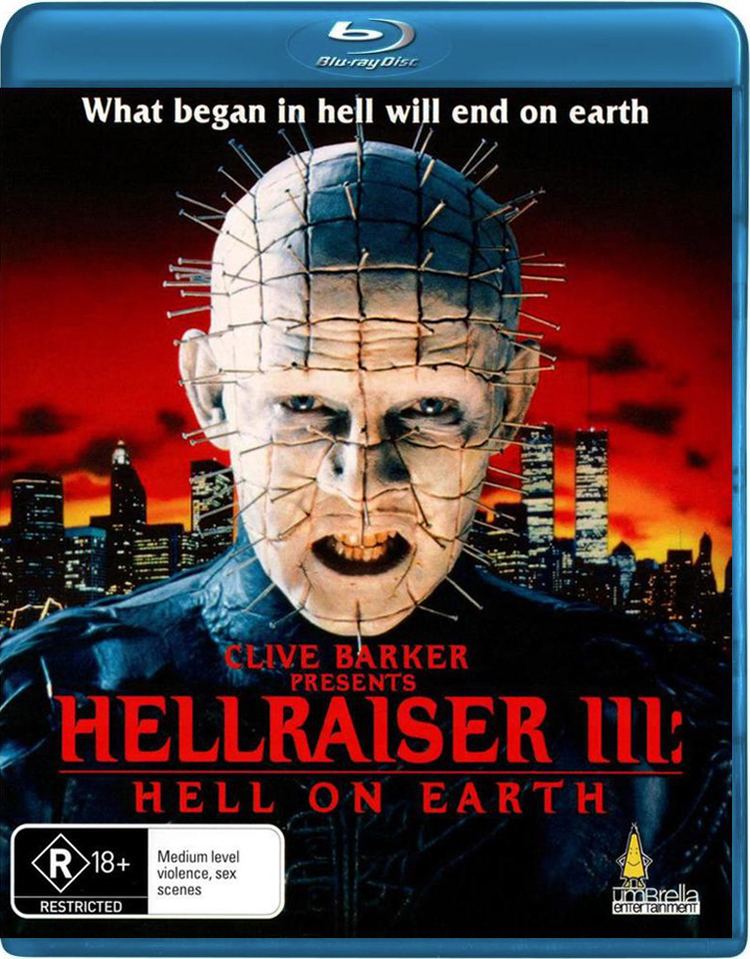
Video tape interviews are recovered from the Channard Institute of one of Pinhead's former victims Kirsty Cotton. Joey and Terri learn through the videos about the demonic Cenobites and how the Lament Configuration puzzle box is the only means of sending Pinhead back to Hell. Pinhead remains dormant until one night several hooked chains shoot out of the pillar and rip into one of the club goers, Sandy, whom Monroe had just recently slept with. After killing Sandy, Pinhead consumes her flesh and her distorted face appears on the pillar. Pinhead convinces Monroe to bring him more club members so he can feed on them and be freed from the pillar.
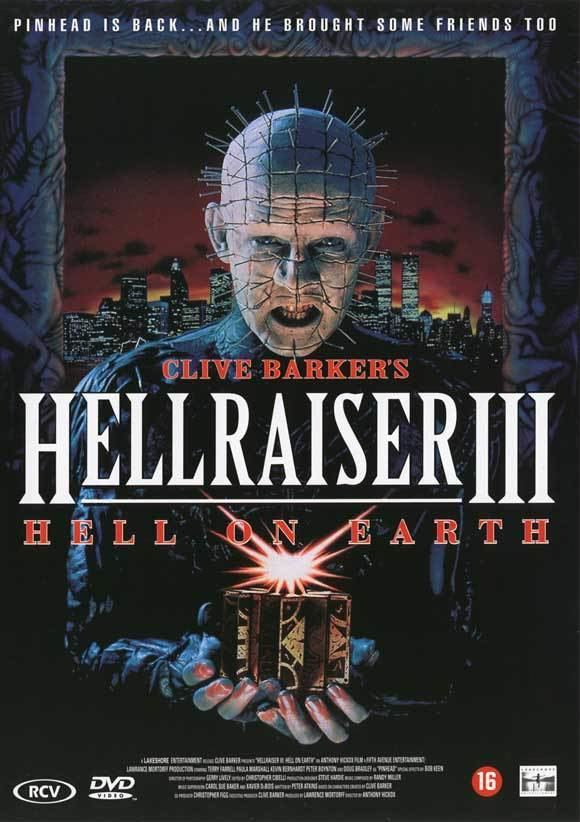
Meanwhile, Joey is contacted by the spirit of Elliot Spencer, who tells her that this "Pinhead" is a separate entity than the one encountered by Kirsty previously. Without Spencer's humanity to act as a balancing influence, this Pinhead is completely evil and has no sense of order. Rather than abide by the laws of the Cenobite realm, he will indiscriminately wreak havoc on Earth for his own pleasure. In order to defeat him, Joey must reunite Spencer's spirit with Pinhead, fusing them back into a single entity.
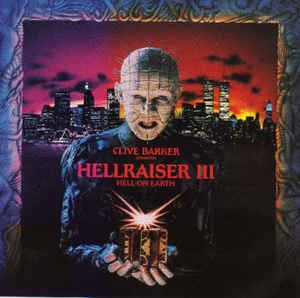
Pinhead and Joey confront each other in The Boiler Room after Pinhead massacres the club's patrons in various grotesque ways. Pinhead says that he exists to force humanity to recognize the darkness in their heart and his freedom is the only way to enable it. He orders Joey to give him the box, but she breaks free and flees the club. Pinhead resurrects the corpses of his victims as Cenobites: Terri, transformed into a cigarette-smoking Cenobite that can dream, which she was unable to do as a human; Monroe, who has pistons jabbed through his skull; the Barman, who has barbed wire wrapped around his head and spits fire from his mouth; The DJ, who has CDs impaled into his skull and throws CDs full speed at his victims; and 'Doc', who has a TV camera forcibly embedded in his eye socket. Joey flees through the quiet streets, pursued by the new Cenobites. Local police are killed by the Cenobites as Joey enters a church and begs the priest to help her. Lacking in faith that demons could exist, the priest is appalled by the appearance of Pinhead. The Cenobites trap Joey on a construction site and prepare to torture her. When the Lament Configuration activates, they are quickly sent to hell. Joey finds herself in a heaven-like realm and comes face to face with an apparition who appears to be her dead father. The apparition tells Joey to give him the puzzle box, only to be revealed as Pinhead in disguise.
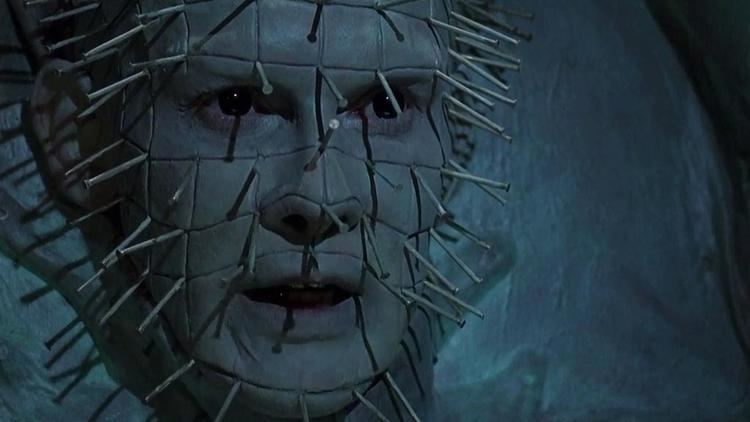
Pinhead ensnares her in machinery and prepares to transform her into a Cenobite. He is confronted by Spencer's spirit, who forcibly fuses himself into Pinhead. Joey breaks free and uses the altered Lament Configuration to stab Pinhead through the heart, finally sending him back to Hell. With Pinhead's humanity restored, Joey buries the Puzzle Box in a pool of concrete at the construction site. Later, the finished product of the same site is revealed: a building built where Joey buried the box, and the interior design is identical to the Lament Configuration.
Cast

Development
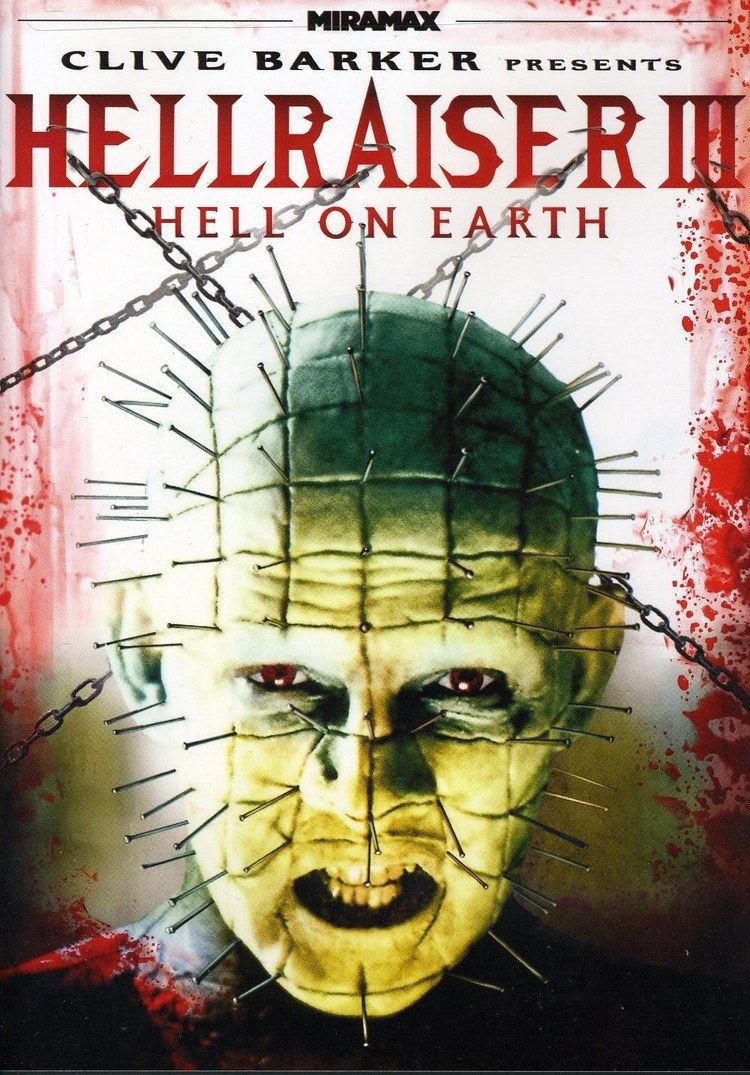
New World Pictures and Film Futures, a production company owned by Clive Barker and Chris Figg, held meetings about a third Hellraiser film before Hellbound was released. Barker had originally intended for the Hellraiser sequels to focus on Clare Higgins' character Julia, but Higgins declined to reprise her role in a third film, and her character was killed off in later drafts of Hellbound. Other ideas included a story set in ancient Egypt, a followup to Hellbound in which Pinhead attempted to resurrect himself, and a building that functioned as a Lament Configuration. Aspects from the latter two would make it into the final script.

During these talks, 20th Century Fox demanded extensive cuts to Barker's latest film, Nightbreed, an adaptation of his novella Cabal. Following a misleading marketing campaign from Fox that promoted it as a slasher film, Nightbreed underperformed at the box office and caused Film Futures to go out of business. With New World's own bankruptcy troubles, Hellraiser III went into development hell. Former New World executives, including Lawrence Kuppin, established Trans-Atlantic Pictures, and the rights were transferred to them. Following disagreements with Trans-Atlantic, Barker had no official involvement in the project until much later, during post-production; he said the studio balked at his fee, as they wanted a "cheap and nasty" film.
Tony Randel, who directed Hellbound, co-wrote the story with Peter Atkins. Atkins completed the first draft of the screenplay in 1991. Many major elements remain unchanged from the shooting script, but the Barbie and CD Cenobites do not exist. The end of the screenplay has Pinhead and Elliott merge into one being, but, following this, Joey makes a deal with him to be his willing bride in return for a successful life. Subsequent rewrites introduced the CD and Barbie Cenobites, Pinhead's deception as Joey's father, and a happier ending. The setting was made unambiguously American, ending the first two films' tradition of mixing British and American elements.
Pre-production
Randel was attached to direct, but the producers removed him after they became worried that his vision for the film was too bleak. Anthony Hickox replaced Randel after a mutual friend, whom Hickox had cast in Waxwork II: Lost in Time, suggested him. Barker, who disliked Hickox's prior work, believed him a poor fit for the Hellraiser series, as Hickox was known for horror comedy films. When Hickox met with him, Barker stressed that he expected Hickox to take the material seriously. Hickox, a fan of the series, agreed and used the first two films as a guide for the proper tone.
Only two actors returned from the prior films: Doug Bradley as the Cenobite Pinhead and, in a cameo, Ashley Laurence as Kirsty. Hickox said he found the casting process for a Hellraiser film both exciting and frightening. The first to be cast was Terry Farrell, who was returning to a career in acting after a break. Hickox had previously sought her for a role in Waxwork II, but, when that become impossible because of a scheduling clash, he promised to cast her in his next project. Kevin Bernhardt, who had appeared as a series regular on General Hospital, was cast as J. P. Munroe. The role of Monroe's girlfriend, Terri, went to Paula Marshall, who Hickox said was a critical casting choice, as the film rested on the performances of Marshall, Ferrell, and Bradley.
For Joey's cameraman, Ken Carpenter, an actor friend of studio executive Kuppin, was cast, as he had the look they wanted: practical and hard-working. Atkins himself took the role of the barman and the subsequent Barbie Cenobite, and several other crew members, including Kuppin and producer Lawrence Mortorff, took cameo roles. Smaller roles were filled with friends-of-friends, local actors, and people who had appeared in prior genre films, including Hickox's Waxwork series.
Most of the crew were new to the series, too. Hickox brought many crew members from his previous films, including cinematographer Gerry Lively, who worked with Hickox on Waxwork II. Bob Keen from special effects company Image Animation was one of the few returning crew members from previous Hellraiser films. Keen had also previously worked on Nightbreed and the Waxwork films. Gary J. Tunnicliffe, who would become a writer and director in later Hellraiser films, joined the film's make-up crew and created the Lament Configuration boxes. Paul Jones replaced Geoff Portass as make-up coordinator.
Filming
Hellraiser III was the first film in the series shot in the United States. Laurence's scene, a recorded interview in which Kirsty explains the series' mythology, was shot separately prior to the rest of the film. Principal photography began in late 1991 in Greensboro, North Carolina, which stood in for New York City. J. P.'s club was set in a furniture factory in neighboring High Point.
Trans-Atlantic gave Hickox six weeks to shoot the film. Hickox had previously established a very fast shooting schedule that used long hours, which meant the Hellraiser III cast had to adjust to his unorthodox style and the studio's demands. Bradley said that he worked for seventeen hours straight one day, and the large number of scenes shot daily meant they had little time to perfect them. Hickox's preference for in-camera editing sped up production but limited the actors' view of the completed film, as it limited the editing phase. Unlike previous Hellraiser films, the stages used were all very close to each other and shared a single sound stage, which made shooting simultaneously with multiple crews difficult.
Though Bradley said he enjoyed the production and working with Hickox, he experienced discomfort in some of his scenes. Early on, Bradley had to act from within the uncomfortable Pillar of Souls prop, where Pinhead is trapped. This limited Bradley's acting to just his face and voice. Bradley also said that the make-up from Hellraiser III was his least favorite. Jones had changed Pinhead's make-up to make it faster to apply and remove, but this had the side-effect of making it more uncomfortable to wear. However, Bradley was able to find an optician that allowed him to wear a prescription version of Pinhead's black lenses, allowing him to stay in-character for much longer periods.
During the sex scene between Aimée Leigh and Burnhardt, Leigh protested at having to appear topless. This was resolved by having Burnhardt place his hands on her breasts, obscuring them. The cast and crew reportedly got along well, and during an on-set visit by Fangoria magazine, the only complaint reported was that Marshall found her outfit too light to shoot during a cold winter night. The scene where Elliott and Pinhead confront each other was difficult to shoot, necessitating a stand-in for Pinhead. Bradley remarked that he felt "jealously protective" of the character when he saw his stand-in, as this was the first time anyone else had ever appeared in-character as Pinhead on a Hellraiser set.
The biggest issue was the Black Mass scene, which caused controversy in socially-conservative North Carolina. Hickox had been refused permission to shoot in a real church, so he used a matte painting as a background to the altar. When the crew complained of sacrilege, Hickox told them it was no different than the countless Hammer horror films in which Christopher Lee, as Dracula, rampaged in churches. Besides that, Hickox reported only a healthy rivalry between Marshall and Farrell, which he welcomed, as it encouraged them to up the ante in their shared scenes.
Post-production
Kuppin suggested that Hickox use the non-linear editing system Edliflex, which was made by a company he owned. This was quickly abandoned after the software turned out to be too time-consuming. Miramax soon became interested in distributing the film in the US, but what happened next is contentious. According to Hickox, Bob Weinstein loved the rough cut he saw and offered Hickox money for additional effects work and to redo the ending. This resulted in an early use of computer-generated imagery – the first in a horror film – to add several gory scenes.
Barker disputes this account and says that Kuppin showed him a work print. Unimpressed, Barker declined an executive producer credit, criticizing the film's ending and low-budget effects work. After Miramax become involved, Barker says Weinstein asked for his honest evaluation of the film. Barker reiterated his criticisms, and, at Weinstein's urging, came in to fix the film. In Barker's account, he was the one responsible for Farrell's bondage scene, additional scenes of extended gore in the nightclub massacre, and the CGI when Leigh's character is skinned. Regardless of the extent of Barker's involvement in post-production, it was now enough for him to accept an executive producer credit, and the film was given a "Clive Barker Presents" banner. Additionally, Barker promoted the film alongside Candyman.
Themes
Writing in The Hellraiser Films and Their Legacy, author Paul Kane identifies several themes in the film. The first, the horrors of war, Kane identifies as the strongest and most pervasive. Hellraiser III homages war films like Apocalypse Now, Platoon, and Born on the Fourth of July. Kane says both Joey and Elliott are depicted as seeking answers following traumatic experiences with war. Joey wants to understand her father's death in Vietnam, and Elliott searches for meaning after losing his faith in both God and mankind. After Elliott's transformation into Pinhead, he commands Hell's forces, and later is shown directing the newly-created Cenobites. Hickox said this is a direct allusion to Elliott's war experiences.
Kane identifies dreams as another common theme, often in terms of how they relate to desire. According to Kane, Joey's nightmares reflect her frustrated ambition to be recognized in her career and beat the glass ceiling. Though her dreams of getting the story of her life come true, she is left no better off, as there is no evidence. Likewise, Pinhead appeals to J. P.'s and Terri's dreams, promising to make their ambitions come true. For Terri, this is more literal, as she desires the ability to dream. Kane says that although the film never explicitly states this, it is clear that Elliott wishes to regain his humanity; more immediately, he seeks to control Pinhead, who, in turn, desires unrestrained freedom.
In Kane's analysis, technology and, specifically, communication devices figure prominently: unplugged radios and televisions transmit warnings from Elliott, Kirsty's warning comes in the form of a videotape, and Joey works in the television industry. The transformed Cenobites are fused with technology, which Kane compares to Tetsuo: The Iron Man. These transformations also illustrate another theme: duality. Many of the characters have an alter ego, such as Elliott and Pinhead. Kane says that although Joey does not have a physical alter ego, her dream-self regresses to that of a young child similar to Lewis Carroll's Alice.
Kane says many of the characters and their relationships in Hellraiser III match to those of the first two films. Like Kirsty, Joey has lost her father, and she finds a new father figure in Elliott. Kane identifies Elliott as a vaguely-hinted-at love interest for her, as he shares a psychic intimacy with her that no living man can. Joey and Terri initially have a relationship similar to Kirsty and Tiffany in Hellbound, then an antagonistic one similar to Kirsty and Julia in Hellraiser. According to Kane, both J. P. and, to some extent, Pinhead mirror Frank's insatiable lust. Kane describes the Cenobites as reflections of the ones from the first two films.
Soundtrack
The film features a heavy metal-rock soundtrack. Initially, the score was also meant to be rock music, but this went over poorly in test screenings. Randy Miller was brought in to compose a more traditional score within three weeks. Given a restricted budget, the Mosfilm State Orchestra and Choir in Russia was chosen to perform the score. The Russian orchestra, unaccustomed to Hollywood demands, felt they did not have enough time to rehearse, but Miller said they eventually welcomed the challenge. Barker directed the Motörhead video for "Hellraiser", featuring Lemmy and Pinhead playing a game of cards and varied clips of the film.
Release
Hellraiser III required several cuts before the Motion Picture Association of America was willing to grant it an "R" rating. Barker ascribed their increased scrutiny to his outspokenness on social issues and the growing popularity of the Hellraiser films, which he said they initially saw as too obscure to care about. It premiered at the Dylan Dog Horror Fest in May 1992. Miramax released the film theatrically in the United States on September 11, 1992. The film debuted in third place, grossing $3.2 million, which the Los Angeles Times characterized as "tepid business". The film grossed $12.5 million in 898 theaters across the United States and Canada, making it second-highest grossing film in the Hellraiser series. It was released on home video in May 1993 and debuted the next month on Billboard' video rental charts at #19. An R-rated version of the film was released on DVD in the US in 2006.
Reception
On release, reviews of Hellraiser III were overall more positive than Hellbound. Kane attributes this to the film's more commercial aspirations than the previous two films. Janet Maslin of The New York Times wrote that the series' mythology had become too complex by this point for newcomers to understand despite its popularity with horror fans. Maslin writes that Pinhead's portrayal makes him of interest to "a more discerning audience", and the film "unfolds as intelligently as it can, under the circumstances". Owen Gleiberman of Entertainment Weekly rated it a letter grade of C− and wrote that the film, though it has a provocative theme, is more oriented toward vulgar depictions of gore than "the thin line separating pleasure and pain". Rotten Tomatoes, a review aggregator that collects both contemporary and modern reviews, reports that 23% of 13 surveyed critics gave the film a positive review; the average rating is 3.7/10.
References
Hellraiser III: Hell on Earth WikipediaHellraiser III: Hell on Earth IMDbHellraiser III: Hell on Earth Rotten TomatoesHellraiser III: Hell on Earth themoviedb.org
